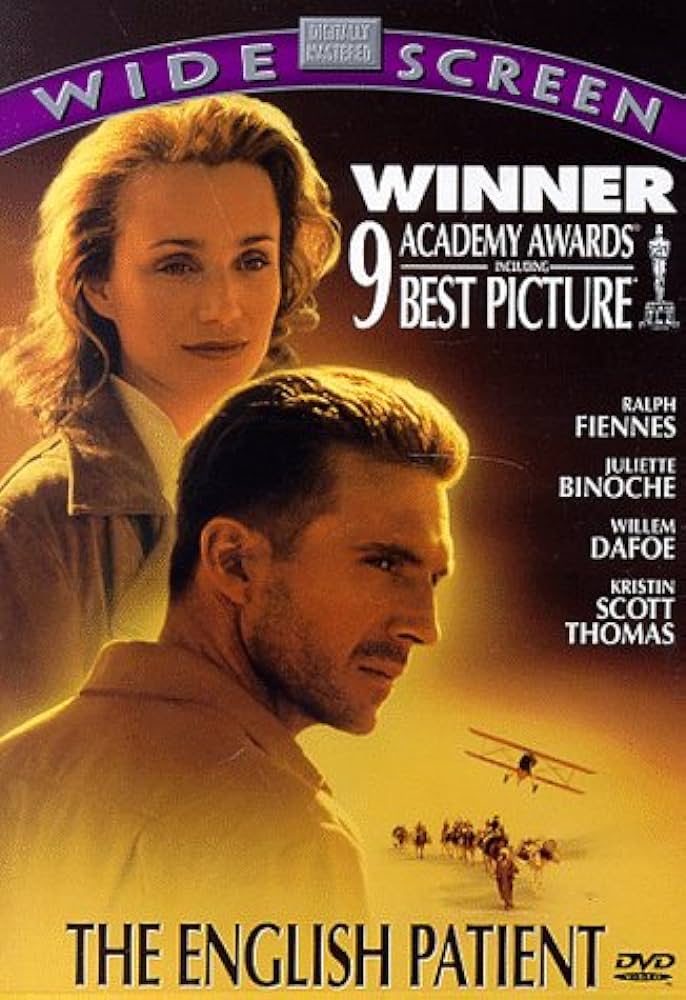“The English Patient”:” (1996): A Mirage of Depth in the Desert of the Oscar Race – Film Review

In 1996, Anthony Minghella’s “The English Patient” swept through cinemas with the force of a desert storm, promising an epic romance set against the backdrop of World War II. Adapted from Michael Ondaatje’s novel of the same name, the film presents a tapestry of love, betrayal, and memory, woven together with stunning visuals and a sweeping score. Yet, beneath its polished surface, “The English Patient” arguably lacks the narrative substance and emotional depth to justify its monumental acclaim, particularly its win for Best Picture at the Oscars, a victory that has since been scrutinized for overshadowing more deserving contenders.
Behind the Scenic Curtain
The making of “The English Patient” was no small feat, with Minghella’s vision bringing together a cast and crew in remote and challenging locations to recreate the film’s intricate wartime and pre-war settings. The production details, from the meticulous design of period-appropriate costumes to the selection of breathtaking landscapes that would stand in for the North African desert, were executed with undeniable skill and dedication. Yet, for all its aesthetic achievements, the film’s narrative often feels as vast and empty as the desert itself, meandering through subplots and flashbacks that, while visually arresting, sometimes detract from the central narrative’s emotional impact.
A Mirage of Depth
At its heart, “The English Patient” explores themes of love, loss, and the irretrievable nature of the past. Ralph Fiennes and Juliette Binoche deliver performances that are both nuanced and compelling, their characters’ stories unfolding against the backdrop of war’s chaos. However, the film’s sprawling narrative and the slow pace at which it reveals its secrets can feel self-indulgent, a cinematic endurance test that demands patience but offers little in the way of narrative innovation or insight.
The film’s critical and commercial success, culminating in its Best Picture win, has been a point of contention. Critics argue that “The English Patient,” for all its technical excellence and artistic ambition, is fundamentally a conventional story dressed in the finery of an epic. Its victory at the Oscars over films like “Fargo” and “Jerry Maguire” — each groundbreaking in their own right for their storytelling, character development, and exploration of uniquely American landscapes and psyches — seems, in retrospect, a choice that favored traditional Oscar bait over cinematic innovation.
The Case for the Underdogs
“Fargo,” directed by Joel and Ethan Coen, is a masterclass in blending dark humor with crime drama, set against the stark, unforgiving landscape of the American Midwest. Its narrative efficiency, unforgettable characters, and biting wit set it apart as not only one of the best films of 1996 but as a landmark in American cinema. Similarly, “Jerry Maguire,” directed by Cameron Crowe, redefined the sports drama with its heartfelt exploration of success, love, and the search for authenticity in a cynical world. Both films offered something “The English Patient” did not: a fresh perspective and a memorable, concise narrative.
Reflecting on the Legacy
“The English Patient” remains a polarizing film, its status as an Oscar darling both a testament to its appeal and a target for criticism. Its technical achievements — from Stuart Craig’s production design to John Seale’s cinematography — are undeniably impressive, contributing to a lush, immersive cinematic experience. Yet, its narrative and thematic ambitions, when stripped of their aesthetic sheen, reveal a story that might not be as profound or as original as its accolades suggest.
As the years have passed, the film’s reputation as one of the Academy’s more questionable Best Picture winners has solidified. This is not to diminish the efforts of the cast and crew, who brought Minghella’s vision to life with undeniable skill and dedication. Instead, it highlights the ongoing debate about what constitutes “best” in the realm of cinema — a debate that “The English Patient,” with its blend of spectacle and sentimentality, continues to provoke.
In the end, “The English Patient” serves as a reminder of the Oscars’ tendency to favor certain types of narratives — those that conform to a traditional, epic mold over those that push the boundaries of genre and storytelling. As viewers and critics alike look back on the film’s legacy, many find themselves wandering through its beautiful, barren landscapes, searching for the depth and innovation that truly define cinematic greatness.




